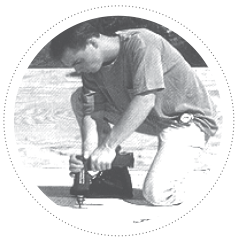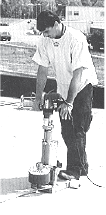Fence Staples are used for fastening fencing to wood posts (about 50 mm (2 in) long) which are available in several lengths and may be galvanized.
Corrugated Fasteners are used for nailing frames, corners and end grain to long grain joints. The corrugated fastener, a short steel strip honed on one edge. Best results will be obtained if the nailing is done with work placed on a solid base.
Fastening into Metal Decks
For best results with mechanically fastened roofing systems, these general rules apply:
Choose only corrosion-resistant fasteners.
 Use the proper tools recommended by the respective fastener manufacturer.
Use the proper tools recommended by the respective fastener manufacturer.- Drive fasteners perpendicular to the top surface of the insulation.
- Hit nail-type fastener heads square on. Otherwise, the heads of some piercing- type fasteners can snap off.
- Remove fasteners that have snapped due to improper driving.
- Position fasteners at least 150 mm (6 in) from the edges of the insulation board.
- Keep the fastening pattern close on the sheet.
- Recess the stress plate and fastener head slightly to avoid abrasion with the next layer of insulation, or the membrane itself, depending on the application.
- On steel decks, periodically examine the underside to ensure the fasteners are engaging at a point on or near the middle of the top flange. (Screws on steel decks should protrude below the minimum of 12.7 mm (1/2 in) or as specified by the fastener manufacturer.
 Snapping a chalk line on the insulation to indicate flange centers can facilitate the proper positioning of the fasteners.
Snapping a chalk line on the insulation to indicate flange centers can facilitate the proper positioning of the fasteners.
Always follow manufacturer’s instructions for the mechanically fastened system to be installed and the instructions of the fastening equipment manufacturer for safety operation.
Proper application procedures are the key to making the roofing system work. No matter how good a fastener is, it cannot do its job if not installed correctly. The most common installation errors are:
- Overdriving of fasteners.
- Under driving of fasteners.
- Over drilling of decks.
- Driving fasteners at angles other than 90° to the top surface of insulation.
- Driving fasteners too close to the edge of insulation boards.
Overdriven and under driven fasteners can both cause problems, but under driven fasteners can be easier to notice and are easier to correct. If not corrected, the inadequate pre-loading allows movement of the stress plate and subsequent back out of the fastener. Damaged insulation and plates are signs of overdriven screws.
Wood Decks
Screws should be sized to penetrate the deck a minimum of 12.7 mm (1/2 in) or as specified by the fastener manufacturer.
Equipment
 When installing mechanically fastened roof systems, proper tools and equipment are essential for proper installation. The most commonly used tool is the screw gun. Tool adapters can be used with the screw gun for proper alignment and ease of application.
When installing mechanically fastened roof systems, proper tools and equipment are essential for proper installation. The most commonly used tool is the screw gun. Tool adapters can be used with the screw gun for proper alignment and ease of application.
Variable speed drills without a torque sensitive clutch should not be used. Use of these drills can cause under driven and overdriven fasteners which is an unacceptable application.
Stand-up tools and the newer short tools enable the installer to better align fasteners, especially longer length fasteners, to prevent wobbling and make sure there is a positive engagement between the bit and the screw head, resulting in less operator fatigue, and increased productivity. Screw guns with depth- adjusting features or torque sensitive clutches help to eliminate improperly installed fasteners.
If you’ve never purchased an electric screw gun, consult with a dealer who knows his electric tools. By telling him the diameter and length of the screws, as well as the gauge of the decks you will be roofing, he or she should be able to recommend the size and duty the job will entail. Again, the tool should have a torque sensitive clutch. Some makers of stand-up tools have magazines that hold stacks of plates and allow installation of both plates and screws mechanically.
Nail-type Fastening and Fastening Systems
Pneumatic, or air-powered fasteners are driven by an air compressor that is attached to the tool by a hose. The staples or nails are loaded into the tool on strips, rolls and coils. Fasteners are driven into the work surface by pressure released from the compressor when the operator pulls the trigger. Pressure is adjustable so fasteners can be driven to varying depths in the work surface. Some of these depth control features function independently, or from air pressure variation, allowing some tools to be used with greater versatility.
Pneumatic tools are just as easy to use and produce the same dramatic increases in production with hard materials like tiles. On most older guns, the driver blade must be ground down to adjust the depth of the drive for tile or a flush drive depth control attachment can be added. The drive can then be adjusted by the turn of a screw. With multiple triggers and cork contacting elements to be depressed before firing, pneumatics are considered to be safer than hand-nailing.
Maintenance should be performed regularly on pneumatic equipment and only air tool oil should be used as other oils can cause internal O-rings to swell. Hoses and air lines should be blown clear and compressors drained to discharge water that condenses in the system.
In an effort to reduce downtime, manufacturers of pneumatic equipment are modifying their tools to include such innovations as pressure relief safety valves, which releases excess pressure at a preset level by bleeding pressure out of the system. The valve automatically resets when the air pressure is reduced to an acceptable level. This reduces down time by alleviating some of the problems associated with jammed pneumatic equipment.
Self-contained, cordless nailers, first introduced in 1988, rely on electrically-fired, combustion engines fuelled by a gas cartridge rather than air pressure. This eliminates the need for a compressor and hoses required to drive the pneumatic driver, which can be a nuisance when there are stacks of tiles on the roof that can get knocked over. They can be an advantage on steep sloped roofs. Cartridges for these cordless nailers add an extra expense, but also can increase productivity in some instances.
